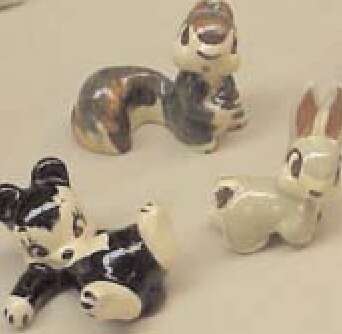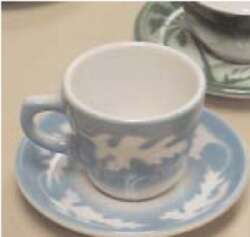©1999-2015
Wisconsin Pottery Association
P.O. Box 705
Madison WI 53701-0705
“MEMBERS FAVORITES” PRESENTATIONS
FROM JANUARY 2003
The following article appeared in WPA Press, Vol. 15, Winter 2003
At the January 2003 WPA meeting, members Jim Tyne, Tom Tompkins, Nancy Spitzer and Steve Dana talked about some of their favorite potteries. Here are some notes and photos from their presentations.
California Figurines
 Jim Tyne talked about ‘California critters’ made by various California
potteries. He brought along several pieces of Winfield Pottery including a
child’s plate and cup whimsically decorated with bears (see photo, below). The
Winfield Pottery of Pasadena, CA, was started in 1929 by Lesley Winfield Sample.
A designer,
Margaret Mears Gabriel, joined the pottery in 1935, and Gabriel and her husband
became owners of the pottery in 1939. Winfield made pottery until 1962, and in
addition to dinnerware, was known for their art pottery pieces in the 1930s. The
pieces are characterized by square bodies with rounded edges and are sturdy and
attractive, with simple patterns, a few featuring Oriental motifs. Almost all
are marked, some as “Gabriel” and others are marked "Winfield". The pottery was
available in fine department stores such as Marshall Fields.
Jim Tyne talked about ‘California critters’ made by various California
potteries. He brought along several pieces of Winfield Pottery including a
child’s plate and cup whimsically decorated with bears (see photo, below). The
Winfield Pottery of Pasadena, CA, was started in 1929 by Lesley Winfield Sample.
A designer,
Margaret Mears Gabriel, joined the pottery in 1935, and Gabriel and her husband
became owners of the pottery in 1939. Winfield made pottery until 1962, and in
addition to dinnerware, was known for their art pottery pieces in the 1930s. The
pieces are characterized by square bodies with rounded edges and are sturdy and
attractive, with simple patterns, a few featuring Oriental motifs. Almost all
are marked, some as “Gabriel” and others are marked "Winfield". The pottery was
available in fine department stores such as Marshall Fields.
 Jim
also brought some animal figurines from Delee Art, a company started by Delee
Art bear in a raccoon skin cap. Jimmy Lee Adair Kohl. Kohl was an artist and
school teacher—she started the company in 1936 with $160 she was awarded after
an auto accident; her attorney became her partner. As many as 20 people worked
for the company at one time.
Jim
also brought some animal figurines from Delee Art, a company started by Delee
Art bear in a raccoon skin cap. Jimmy Lee Adair Kohl. Kohl was an artist and
school teacher—she started the company in 1936 with $160 she was awarded after
an auto accident; her attorney became her partner. As many as 20 people worked
for the company at one time.
Jim noted that one can find pieces of Delee pottery in almost all antique malls. The Delee pieces are easily recognizable by their characteristic elongated eyelashes. Most pieces are marked, although the bottoms are sometimes glazed, making the marks hard to read. Delee also has silver labels. The company survived into the 1950s.
If you care to read more about them, Schneiders’ California potteries book covers the Winfield and Delee potteries, Jim advises.
 Finally, the Winton Brothers, Don and Russ, twins born in
1919. The Winton twins were considered boy geniuses, and were known for
their art and ceramics. They made figurines based on Disney characters
(until Disney discovered this). Helen Burke was their designer (1938-39),
hence a Burke/Winton mark. In 1946 the twins joined the army and their
brother, Bruce took over the pottery, continuing into the 1970s. Many items
were marked "twin-Win", such as cookie jars, salt and peppers, and were very
popular.
Finally, the Winton Brothers, Don and Russ, twins born in
1919. The Winton twins were considered boy geniuses, and were known for
their art and ceramics. They made figurines based on Disney characters
(until Disney discovered this). Helen Burke was their designer (1938-39),
hence a Burke/Winton mark. In 1946 the twins joined the army and their
brother, Bruce took over the pottery, continuing into the 1970s. Many items
were marked "twin-Win", such as cookie jars, salt and peppers, and were very
popular.
Another mark for the Winton Pottery is “Don Winton Designs". Twin Don was their main designer; in fact, Don did design work for several other companies as well.
Jim feels that the pre-war figures, 1936-41, are the best produced by the Wintons. One of the Winton’s most popular and collectible pieces is the “Hilter skunk”, but all the figurine characters have very expressive faces, showing emotions such as surprise and bewilderment.
 North
Carolina Pottery
North
Carolina Pottery
Tom Tompkins talked about some of his favorites, found
during a trip to North Carolina (one piece pictured above). Tom and Nancy
visited the Seagrove area where many potteries are found. Tom talked about
the Pisgah Forest Pottery, Arden and pottery made by Evan Brown, whose
family is still producing pottery where he first opened shop in 1961. Evan’s
father Jay Van Brown worked at this shop and his daughter Cherry and wife
Mercedes currently work there. Evans’ pots occasionally show up in antique
malls in Wisconsin.
Pisgah Forest Pottery is just down the road, sitting in a picturesque valley. The pottery opened in 1926—Walter Steven was an early potter there. Some of the pieces are marked with dates.
The Seagrove area includes some 90 potteries, including Jugtown Pottery, opened 1917, started by a couple educated in art. The wife kept a job in New York City and sold pieces there. Ben Owens started at the Seagrove pottery as an eighteen-year-old, and continued until 1959.
A nonprofit organization, Country Road, bought Jugtown in the 1960s and redeveloped glazes to remove lead. Jugtown is now owned by Vernon Owen.
Ben Owen started his own pottery in 1959—he has since died but his grandson Ben Owen III now runs the pottery.
 RESTAURANT
CHINA
RESTAURANT
CHINA
Nancy Spitzer counts among her favorites,
Restaurant china, something most of us have enjoyed eating from at one time or
another.
Buffalo, Sterling and Shenango, Syracuse and Jackson are some of the chinas known as restaurant ware. If you wish to consult a text, Nancy mentioned Conroy’s book on restaurant china as a good resource. Syracuse china is a favorite of Nancy’s. It is a highly fired, vitrified china. Syracuse is a very old company and at one time made china for all of the major railroads and steamships.
 Onondaga Pottery Company became the Syracuse China Company.
Nancy mentioned that Guy Cowan, founder of Cowan Pottery, designed for
Syracuse china during the depression. In fact, Guy Cowan’s father also
worked for the company.
Onondaga Pottery Company became the Syracuse China Company.
Nancy mentioned that Guy Cowan, founder of Cowan Pottery, designed for
Syracuse china during the depression. In fact, Guy Cowan’s father also
worked for the company.
Guy made a number of design improvements to Syracuse China that were patented. One was called the dart and egg design. Another, the Econorim, was invented by Cowan to help make the plates fit together when they were stacked, taking up less space when stored in the railcar kitchens, while still holding a satisfactory amount of food. The Mark Bassett/Victoria Naumann book on Cowan Pottery has a chapter devoted to restaurant china that describes the patents awarded to Syracuse China, due to Guy Cowan’s inventiveness.
Last but not least was Steve Dana’s talk on designer Paul E. Cox (1879-1968). Cox was born on February 8, 1879 in Baton Rouge, Louisiana. He grew up in Gas City, Indiana, the son of a stoneware manufacturer, and very interested in art pottery. As a youngster he worked with his father in many aspects of manufacturing stoneware, and when he entered Alfred University’s School of Clay-Working and Ceramics he had considerable practical knowledge as well as appreciation for art pottery.
On April 12, 1900, Governor Theodore Roosevelt signed legislation establishing the New York State School of Clay- Working at Alfred. The school had opened in 1836 by Seventh Day Baptists. Charles Fergus Binns was hired as the director around 1900. Cox joined the student body around the same time and became the second graduate of the new school in 1905 with a degree in Ceramic Engineering and Technology.
After graduating. Cox held a number of positions in Indiana and Illinois.
In 1907 Paul Cox married Jean Marie Fortier in New Orleans, LA and in 1910 was hired at Newcomb College, New Orleans, as head ceramist. He was Newcomb's first professionally-trained ceramist. Aside from teaching he was also the glaze technician.
While at Newcomb he improved the clay processes and worked on making matte glazes. He developed the semi-opaque, matte glaze used over relief renderings. This became the moon-over-moss (or moon-and-moss) motif and replaced the standard Newcomb gloss glazes. Moon-over-moss continued to be the main glaze until Newcomb closed in 1940.
In 1918 Cox left Newcomb to assist in the war effort. He went to France and helped set up a grinding wheel factory outside of Paris. While in France he visited the Sevres factory, where he learned about their techniques.
Sometime around his return to the U.S. Cox was hired by Iowa State College (1920- 21) as an associate professor, eventually becoming acting department chair, and in 1926, department chair. Cox traveled about Iowa educating the public about ceramics and it’s importance to industry. He emphasized both art pottery production and the technical aspects of ceramics.
In about 1924 Cox hired Mary Yancy, a Newcomb graduate, as an instructor at Iowa State. Yancy’s strengths were decorative design. Circa 1926 Cox and Yancy began selling art pottery that they produced, using the proceeds for the purchase of school equipment. Cox threw the pieces and created glazes while Yancy did the design work. Their collaboration ended in 1930 when Yancy left to get married.
Cox left Iowa State in 1939 to pursue his own company—all student production at Iowa State ceased at that time. He returned to Hanrahan, LA, outside of New Orleans and started his own pottery plant. His idea was to use the plant for pottery for the home, such as dinnerware and utilitarian ware and Newcomb-styled pieces, as well as certain types of unusual building material. The plant was to serve as a research laboratory as well as for pottery production. Production ended in 1942 as Cox again joined the war effort as a ceramics engineer.
During his lifetime Paul Cox received numerous awards and metals, including an honorary doctorate degree from Alfred University (1936) and the Charles Fergus Binns Medal for Excellence (1952). He was recognized as a prolific writer and spent time assisting others with their pottery ventures.
Paul Cox died in 1968 at age 89.
Our thanks to WPA members Tom Tompkins, Nancy Spitzer, Jim Tyne and Steve Dana for these excellent presentations!









 PAUL E. COX (1879-1968)
PAUL E. COX (1879-1968)